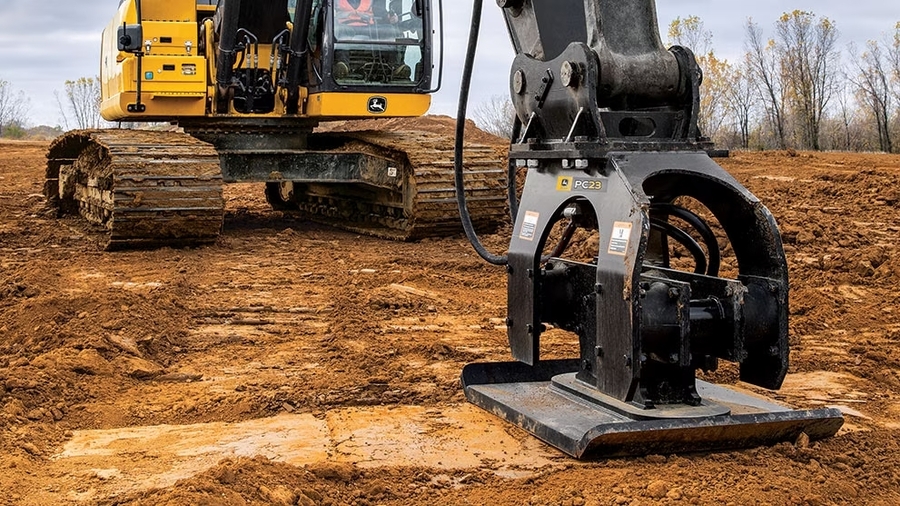What Is a Plate Compactor for Excavators and How to Use It?

Table of Contents:
1. The Importance of Compaction
2. How Compaction Works?
3. The Types of Plate Compactors
4. How to Use Excavator Plate Compactors?
A plate compactor is a piece of equipment frequently used on construction sites. Its main purpose is to compact soil and gravel. Such preparation enables smoothening the surface before commencing further works such as landscaping or paving. In this article, we would like to introduce you to the types of plate compactors, how they work, and how to operate them effectively.
The Importance of Compaction
Before we move to the features of plate compactors, we would like to answer the question: is compaction necessary?
The role of compaction is to provide the base for the foundation. Compaction assures the proper compression of the soil particles. Thanks to it, the number of pores between the particles is lower, and the soil density is higher. Ultimately, the surface is less likely to shift as a result of water moving through the soil.
Water can also freeze and thaw in the pores. Because frozen water expands, the pavers get lifted. Such movement can contribute to the lack of stability and result in damage to the structure of the foundation. Furthermore, uneven surfaces can become a health and safety hazard.
Compaction is a necessary step in the construction or building process that hardly any contractor skips. However, not many know that landscape projects also require stable foundations that can only be built on properly compacted soil and with the help of appropriate compaction equipment. The best tools that help to achieve proper compaction are the excavator plate compactors.
How Compaction Works?
To ensure proper compaction, a plate compactor pounds or vibrates. As a result, a heavy steel plate attached to the bottom of the tool levels the soil beneath it. The weight of the machine helps to create an impact force, which in combination with the vibrating action, causes soil particles to move. As they move, the air pockets disappear and the soil underneath the tool becomes compact.
The Types of Plate Compactors
Because there are various soil types an operator can compact, there are also several types of plate compactors.
Single Plate Compactors
Single plate compactors are light and small compared to the other types of compactors. Single-plate compactor compresses in one direction, which causes limited manoeuvrability. It can also cover only a small area at a time. This type of equipment works best on asphalt, gravel, or dirt.
Reversible Compactors
Reversible compactors can compress while moving forward and backwards. This ability allows the operator to work in large areas. The force the reversible compactors exert can reach even 9000 pounds, which allows for deep compaction. This piece of equipment is indispensable in such works as building driveways.
Heavy-Duty or High-Performance Plate Compactors
This piece of equipment can exert the highest force of all plate compactors. It is designed to handle the compaction of soils that contain clay.
Hydraulic Plate Compactors
This type of plate compactor is attached to the excavator and backhoes instead of buckets. They work with greater speed and productivity than regular plate compactors. Hydraulic plate compactors also work well on steep slopes, rough terrain, and next to various obstructions. Another significant advantage of plate compactor attachments is their ability to distance operators from the place of compaction. It ensures their greater safety (in case of, for example, cave-ins).
How to Use Excavator Plate Compactors?
The time has come to put the knowledge into practice. To ease you into the task, we prepared an easy step-by-step manual on how to use plate contractors. Follow the below three steps to get the best results at soil compaction.
Step 1: Use Rakes
It is crucial to smoothen the surface before using a plate compactor. It helps the plate compactor move easier across the surface.
Step 2: Take Care of Health and Safety
Health and safety always come first. Make sure that you wear protective clothing such as masks, glasses, gloves, and earplugs. Plate compactors are noisy machines that may severely impair your hearing. Also, check for any signs of fuel leakage.
Step 3: Start Compressing the Soil
- Lower the excavator’s boom and slowly press the compactor vertically to the ground .
- Gradually lower the boom as the compaction progresses. Keeping a constant applying pressure is essential.
- Make sure that your machine compacts in straight lines. Use the overlapping pattern technique (move perpendicular to the previous straight line). It helps to avoid inadequate compaction.
- Adjust working time to your equipment specifications. Continuous operation for periods longer than recommended may damage the plate compactor or the excavator.
Are you looking for a perfect excavator plate compactor that will help you quickly compress soil or stone over large areas? Our Blue Diamond Attachments will do wonders! Choose the model according to your excavator weight and prepare the soil for further work in no time!
Maximize the potential of your excavator with top-quality attachments. Contact our SkidSteers.com team and let us help you find the perfect solution for all your needs!

